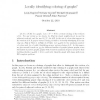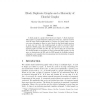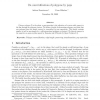96
Voted
CORR
2010
Springer
14 years 11 months ago
2010
Springer
Let G = (V, E) be a graph. Let c : V → N be a vertex-coloring of the vertices of G. For any vertex u, we denote by N[u] its closed neighborhood (u and its adjacent vertices), an...
77
Voted
CORR
2010
Springer
15 years 5 days ago
2010
Springer
A graph G is (a, b)-choosable if for any color list of size a associated with each vertices, one can choose a subset of b colors such that adjacent vertices are colored with disjoi...
103
Voted
COMGEO
2008
ACM
15 years 6 days ago
2008
ACM
Consider a planar straight line graph (PSLG), G, with k connected components, k 2. We show that if no component is a singleton, we can always find a vertex in one component that s...
DM
1998
15 years 8 days ago
1998
The total chromatic number zt(G) of a graph G is the least number of colors needed to color the vertices and edges of G so that no adjacent vertices or edges receive the same colo...
84
Voted
DAM
2002
15 years 13 days ago
2002
A block graph is a graph whose blocks are cliques. A block duplicate (BD) graph is a graph obtained by adding true twins (i.e., adjacent vertices with the same closed neighborhood...
108
Voted
GC
2007
Springer
15 years 17 days ago
2007
Springer
A clique is a set of pairwise adjacent vertices in a graph. We determine the maximum number of cliques in a graph for the following graph classes: (1) graphs with n vertices and m ...
104
click to vote
DM
2006
15 years 19 days ago
2006
An L(h, k)-labeling of a graph G is an integer labeling of vertices of G, such that adjacent vertices have labels which differ by at least h, and vertices at distance two have lab...
112
Voted
DM
2008
15 years 20 days ago
2008
A (p, 1)-total labelling of a graph G is an assignment of integers to V (G) E(G) such that: (i) any two adjacent vertices of G receive distinct integers, (ii) any two adjacent ed...
92
Voted
DM
2010
15 years 21 days ago
2010
Given a polygon P in the plane, a pop operation is the reflection of a vertex with respect to the line through its adjacent vertices. We define a family of alternating polygons, a...
84
Voted
DM
2010
15 years 21 days ago
2010
The chromatic capacity of a graph G; CAP (G) ; is the largest integer k such that there is a k-colouring of the edges of G such that when the vertices of G are coloured with the s...





